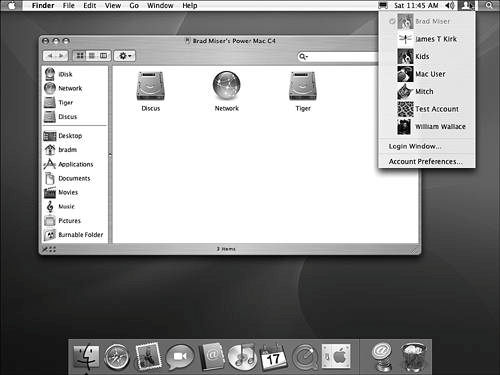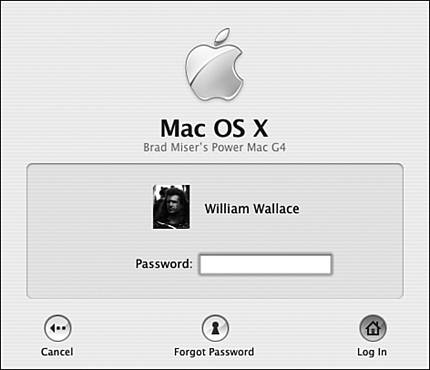Configuring the Login Process
| You can configure the Login window and process in a number of ways:
The following sections explain these options in detail. Configuring Automatic LoginWhen you started Mac OS X for the first time, you were in the Automatic Login mode. In this mode, you don't have to enter login information; Mac OS X does it for you. This means that you don't have to enter a username and password each time you start or restart your machine; by default, the first user account (created during the Mac OS X installation process) is used. CAUTION You should enable Automatic Login mode only if you are the only person who uses your Mac. If you enable Automatic Login mode with the administrator's account, you provide access to many of your system's resources, which is an unsecure way to operate. However, if you have a Mac in a secure location and are the only person who uses it, the Automatic Login mode eliminates the need to log in every time you start or restart the machine. TIP If you are going to enable Automatic Login mode, create a non-administrator account to use. That way, even if someone does get access to your Mac, he won't be able to use the administrator account. Of course, you might have to log out and then log back in as the administrator to perform certain tasks, but this strategy provides a good compromise between security and convenience. To configure the Automatic Login mode, use the following steps:
The next time you start or restart your Mac, the account you specified is automatically logged in and you move directly to the desktop for that account. This setting affects only the start or restart sequence. When you log out instead of shutting down or restarting, you still see the Login window again and have to log in to resume using the Mac. To disable automatic login, uncheck the "Automatically log in as" check box. Controlling How User Accounts Appear in the Login WindowYou can configure several aspects of how user accounts appear in the Login window:
NOTE As you will learn later, most of the changes you make using the System Preferences application are implemented immediately so you don't need to save them. In fact, you can leave the application open and make changes as needed. These are reflected in your Mac's operation immediately. Hiding the Sleep, Restart, and Shut Down ButtonsIf you enable Automatic Login mode, you might run into trouble if you leave the Restart and Shut Down buttons in the Login Window enabled. Here's how that could happen. Say you are using your Mac and decide that you want to take a break for a while, but there are people in your area whom you don't want to be able to use the machine while you step away. You log out, and your machine is protected, right? Not necessarily. If the Restart and Shut Down buttons are enabled, someone can restart the Mac from the Login window and then it would start up in the automatic account, giving the person access to the machine. Disabling these buttons prevents someone from using them to access an account that is automatically logged into. The previous scenario might make you pause to ask a question before you enable Automatic Login mode. If you do disable the Restart and Shut Down buttons and then log out, can someone simply press the hardware Restart or Reset button on the CPU to start up the Mac to automatically log in to the automatic login account? This would bypass the protection offered by disabling the buttons, right? Nope; when the Mac is not shut down properly (by using the Shut Down command), the automatic login feature is disabled when the machine is started or restarted the next time. So, if you have to use one of those buttons, you must log in the next time you start or restart the machine. To disable the Sleep, Restart, and Shut Down buttons, do the following:
When the Login window appears, these buttons are hidden and the only way to use the Mac is to log in under a valid account. If you want these buttons to appear in the Login Window again, simply check the check box. When these buttons do appear in the Login Window, the related actions can be performed without being logged into a user account. Showing the Input Menu in the Login Window
Having the Contents of the Login Window Read to You
Showing Password HintsYou learned earlier that you can configure password hints that are displayed to help a user remember her password. If you check the "Show password hints" radio button, the Forgot Password button is displayed on the Login Window. When a user clicks this button, the password hint appears. If the user tries to log in, but is unsuccessful in three attempts, the password hint appears even if he doesn't click the Forgot Password button. NOTE If the user clicks the Forgot Password button, it becomes the Password Reset button. If this button is clicked, the steps to reset a password by using the installation disc are shown. This is usually a last resort. It is better to reset a user's password via the Account tools. Enabling and Using Fast User SwitchingWhen a user logs out of his account, all documents are closed and all applications and processes are quit. When a user logs in again, any of these must be restarted to get back to where the user was when he logged out. Prior to Mac OS X version 10.3, this process had to be suffered every time users changed. As of the release of Mac OS X 10.3 and later, you can take advantage of fast user switching. What this means is that you can log in to another user account without logging out of the accounts that are currently logged in. This is very nice because you can leave applications and documents open in an account and log out to prevent someone from using those items. And, another user can log in and work with his account. When he is done, you can log back in to your account and everything will be as it was when you left it. This saves a lot of time and hassle reopening items, and processes you are running can continue to run while another user is logged in to the machine. NOTE If your Mac has limited RAM, you might not want to enable Fast User Switching because applications running under other user accounts will consume resources even if your user account is the active one. This means performance might be slower for you because the applications under other user accounts are using RAM and so it isn't available to your applications. To enable this feature, do the following steps:
Then, logging in and out of accounts can be done fast and easily with the Fast User Switching menu (see Figure 2.17). Figure 2.17. The Fast User Switching menu enables you to log in to other accounts without logging out of the current one. To log in under another account, select it on the menu. You will see the Login window with the account you selected (see Figure 2.18). Enter the password for the account and click the Log In button or press Return. After a cool, 3D spinning effect, that user is logged in and his desktop appears. Figure 2.18. Perhaps William needs to use his Mac to plan his next move.
NOTE Sadly, not all hardware can handle the spinning 3-D effect. If you use an older Mac, you might not get to enjoy this cool effect. TIP If you create a user account without a password and enable the Fast User Switching feature, you can log in to the account without a password immediately by selecting it on the Fast User Switching menu. You will bypass the Login Window altogether. To temporarily block access to the current user account without logging out, open the Fast User Switching menu and select Login Window. The Login window will appear. You can leave the machine without worries that someone will be able to access your account. When you are ready to log inor when anyone else is, for that matterselect the user account, enter a password, and click Login (you get to see the cool 3D spin again, too). NOTE On the Fast User Switching menu and in the Login window, users who are currently logged in have the circle with a check mark icon next to them. If another user account is logged in and you attempt to restart or shut down the machine, a warning dialog box appears that explains that other users are logged in and the action you are taking could cause them to lose data. If you enter an administrator username and password and click Shut Down or Restart, the other users are logged out and the action you want is performed. Be careful about doing this though since the other users can lose unsaved data. TIP You can jump quickly to the Accounts pane of the System Preferences application by selecting Account Preferences on the Fast User Switching menu. |
EAN: 2147483647
Pages: 317

 To learn about working with languages,
To learn about working with languages, 